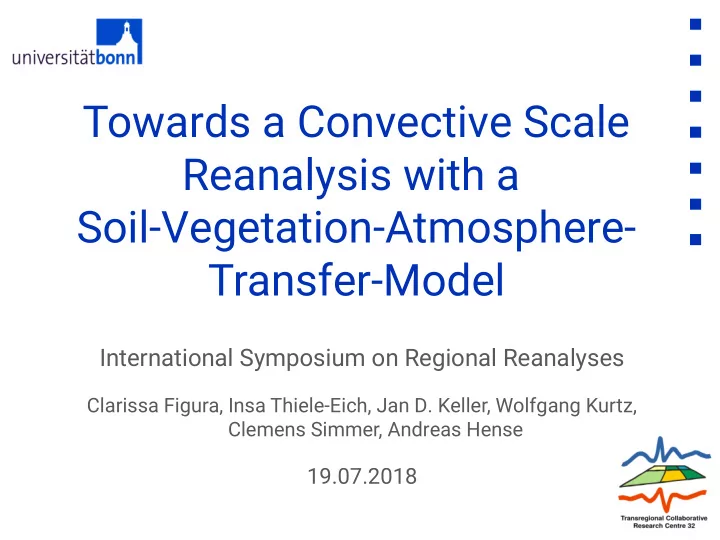

Towards a Convective Scale Reanalysis with a Soil-Vegetation-Atmosphere- Transfer-Model International Symposium on Regional Reanalyses Clarissa Figura, Insa Thiele-Eich, Jan D. Keller, Wolfgang Kurtz, Clemens Simmer, Andreas Hense 19.07.2018
Motivation Reanalyses offer spatially and temporally consistent data sets for global or regional grids and a certain vertical exent within the land surface and atmosphere. Applications: • Renewable Energy Sector • Regional climate analyses • Hydrology • Agricultural economics
Motivation Reanalyses offer spatially and temporally consistent data sets for global or regional grids and a certain vertical exent within the land surface and atmosphere. Applications: • Renewable Energy Sector • Regional climate analyses • Hydrology • Agricultural economics Demand for regional reanalyses is growing!
Challenges 1 Misrepresentation of hydrology (soil moisture-evaporation- precipitation feedback) in atmospheric reanalyses, especially at catchment scale • Betts et al. 1998 and 2003: Investigations of water and energy budget in ECMWFs reanalysis for Mississippi and subbasins → Coupled reanalysis approach
Challenges 2 There exists a coupling between convection triggering and soil moisture (Cioni and Hohenegger, 2017) • idealized LES-Simulations show a strong coupling between soil moisture and diurnal precipitation cycle Convective scale setup
Challenges 3 Models are not perfect due to parametrizations and the chaotic nature of the systems they represent (Lorenz, 1969). Ensemble approach with perturbed realizations
Experimental setup TerrSysMP With kind permissions of P. Shrestha and M. Sulis
Experimental setup KENDA (Kilometre Scale ENsemble Data Assimilation) is a Local Ensemble Transform Kalman Filter
Experimental setup KENDA
Experimental setup KENDA
Experimental setup KENDA → Basic Cycling System (BaCy) Observations Observations COSMO COSMO COSMO COSMO … LETKF LETKF Ensemble Ensemble Ensemble Ensemble Since March 2017 operational at Deutscher Wetterdienst
Experimental setup KENDA with TerrSysMP ...work in progress Observations Observations TerrSysMP TerrSysMP TerrSysMP TerrSysMP … LETKF LETKF Ensemble Ensemble Ensemble Ensemble
Experimental setup EMVORADO (Efficient Modular VOlume RADar Operator) → Radar forward operator QR H EMVORADO QS … Model Simulation of = x b = y b output radar beams
Experimental setup LETKF LETKF TerrSysMP TerrSysMP TerrSysMP TerrSysMP ?
Experimental setup
Preliminary work COSMO-REA6 COSMO 4.25/TERRA • ∆xy= 6 km • Atmospheric boundary: ERA-Interim • Data assimilation: • Nudging of conventional observations (e.g., buoys, radio soundings, aircraft) Soil Moisture / Snow / SST Analysis
Preliminary work Long-term deterministic TerrSysMP simulation (Mauro Sulis) TerrSysMP fully coupled (COSMO 4.x, CLM 3.5) • ∆xy=1000 m/ 500 m • Atmospheric boundary: COSMO-DE-Analysis • Downscaling (no data assimilation) •
First results Ensemble TerrSysMP downscaling TerrSysMP fully coupled (COSMO 5.1, CLM 3.5) • ∆xy=1000 m/ 500 m • Atmospheric boundary: COSMO-DE-KENDA-Analysis • Time period: 16.05.-13.06.2014 •
First results Case study: Front 12 h accumulated rain [mm] for 21.05.2014 00 UTC - 21.05.2014 12 UTC
First results Case study: Convection 12 h accumulated rain [mm] for 22.05.2014 12 UTC - 23.05.2014 00 UTC
First results Feedback precipitation – soil moisture 28.05.2014 IQR Stdev Soil moisture (pressure) Precipitation (mm/24h)
First results Feedback precipitation – soil moisture 26.05.2014 IQR Stdev Soil moisture (pressure) Precipitation (mm/24h)
First results Contingency table Observed yes no false hit yes alarm Model correct no miss negatives Observations: www.bremerhaven-wetter.de 68 DWD rain gauges stations in NRW domain
First results Contingency table 16.-22.05.2014 Threshold: 0.1 mm/h Model BIAS ETS Log Odds COSMO-REA6 1.71 -0.03 -2.36 TSMP det 1.13 -0.04 -2.09 TSMP ens 1.04 -0.05 -1.78 Threshold: 0.2 mm/h Model BIAS ETS Log Odds COSMO-REA6 2.95 -0.01 -∞ TSMP det 1.06 -0.03 -∞ TSMP ens 0.95 -0.03 -2.62
First results Contingency table 16.-22.05.2014 Threshold: 0.1 mm/h Model BIAS ETS Log Odds COSMO-REA6 1.71 -0.03 -2.36 TSMP det 1.13 -0.04 -2.09 TSMP ens 1.04 -0.05 -1.78 Threshold: 0.2 mm/h Model BIAS ETS Log Odds COSMO-REA6 2.95 -0.01 -∞ TSMP det 1.06 -0.03 -∞ TSMP ens 0.95 -0.03 -2.62
First results Shortcomings in representation of precipitation: → Data assimilation (LETKF) is expected to enhance the results
Conclusion • Qualitatively TerrSysMP with dynamic downscaling of analyses is able to better reproduce small scale precipitation events in comparison to COSMO-REA6 • Extended simulation time period necessary to evaluate the quantitative accuracy of precipitation with verification scores
Outlook • Extended time period with TerrSysMP-KENDA with EMVORADO planned • Quantitative model comparison and verification in terms of precipitation and soil moisture with independent observations • Evaluation of feedback of soil moisture on precipitation • Evaluate impact of initial conditions
Towards a Convective Scale Reanalysis with a Soil-Vegetation-Atmosphere- Transfer-Model International Symposium on Regional Reanalyses Clarissa Figura, Insa Thiele-Eich, Jan D. Keller, Wolfgang Kurtz, Clemens Simmer, Andreas Hense 19.07.2018
First results Contingency table Frequency Bias (BIAS): • BIAS=(hits+false alarms)/(hits+misses) • ratio of the frequency of modeled events to the frequency of observed events → BIAS <1: underforecast, BIAS >1: overforecast, perfect: 1 Equitable Threat Score (ETS): ETS=(hits+hits random )/(hits+misses+false alarms-hits random ) • • fraction of observed and/or modeled events that were correctly predicted, adjusted for hits associated with random chance → Range: -1/3 to 1, no skill:0, perfect: 1 Log Odds Ratio (LOR): • LOR=log((hits+correct negatives)/(misses+false alarms)) • ratio of the odds of making a hit to the odds of making a false alarm → Range: -∞ - +∞ no skill:0, perfect: +∞
Recommend
More recommend